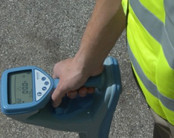
Utility locating ensures the proper and safe installation, repair, and maintenance of underground utility lines.
Utility locating ensures the proper and safe installation, repair, and maintenance of underground utility lines. Check out these five things you didn’t know about utility locating.
Approximate Depths
There aren’t any assumptions when it comes to depths of utilities. Instead, industry professionals use technology and their skills to approximate depths. Even with distances that are less than a city block, the depth of the utility will sometimes dip or rise. That is because the surface grade will change due to a number of circumstances, therefore changing the location of the utilities since it was originally installed. To verify the location of utilities, they have to be exposed.
Exposure
According to regulations set by the Occupational Safety and Health Administration, exposure shouldn’t just be to the depth of the existing utility because there could be more utilities hiding beneath those. It must be verified that there aren’t any utilities below by exposing to the depth of the intended bore path. Professionals have to observe the drill head every time it passes the utility and reamer.
Sewer Lines
Professionals need to use one of the many available methods to locate sewage lines to avoid several dangerous complications. Ground penetrating radar, better known as GPR, is one tool that professionals use to verify the location of sewer lines. Without this important information, a breached sewer line will eventually clog and require the repair of a plumber. The intersection of the utility line and the sewer line will leave the plumber exposed to electrocution. If the utility is a gas line, the gas will migrate into several dwellings and possibly ignite.
Locate Marks
If you don’t see any marks indicating the presence of utilities, it could just mean that they haven’t been located yet, not that there aren’t any there at all. If the lines have been privately installed, they may not be recorded by utility companies or the locating service. A visual inspection of any disturbed or repaired soil or pavement is the first step in indicating if lines are present.
Calling 811
A call to 811 before beginning any digging projects is important, but they do not locate utilities. It is still the responsibility of anyone doing excavation work to verify the location of any and all utilities.
Concrete Construction Safety Tips from Concrete Visions
Concrete Visions has over 12 years of experience and expertise in concrete scanning and we know how to detect any problems lurking beneath the surface. We use ground penetrating radar accurately and expertly and are familiar with many other methods that can be used when appropriate like concrete x-ray and electromagnetic conductivity. We are also very familiar with the latest construction safety techniques and train all of our workers to do their work quickly, accurately, and safely. If you would like to learn more about how we can help you, give us a call at (410) 766-2210 or visit us online. For more articles and tips
